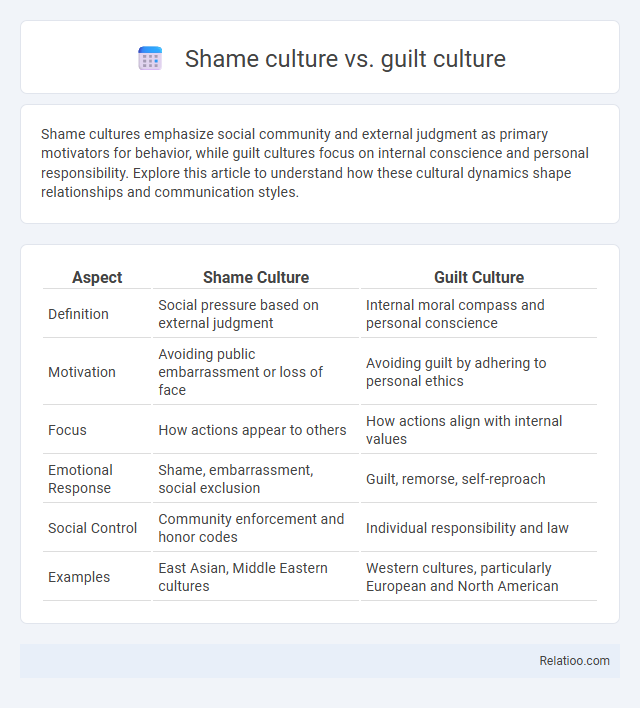Shame cultures emphasize social community and external judgment as primary motivators for behavior, while guilt cultures focus on internal conscience and personal responsibility. Explore this article to understand how these cultural dynamics shape relationships and communication styles.
Table of Comparison
| Aspect | Shame Culture | Guilt Culture |
|---|---|---|
| Definition | Social pressure based on external judgment | Internal moral compass and personal conscience |
| Motivation | Avoiding public embarrassment or loss of face | Avoiding guilt by adhering to personal ethics |
| Focus | How actions appear to others | How actions align with internal values |
| Emotional Response | Shame, embarrassment, social exclusion | Guilt, remorse, self-reproach |
| Social Control | Community enforcement and honor codes | Individual responsibility and law |
| Examples | East Asian, Middle Eastern cultures | Western cultures, particularly European and North American |
Understanding Shame Culture: Definition and Characteristics
Shame culture is defined by the importance placed on social approval and maintaining honor within a community, where individuals regulate behavior to avoid public disgrace. Characteristics include strong external social controls, emphasis on face-saving, and collective judgment serving as a deterrent against misconduct. Unlike guilt cultures that rely on internal conscience, shame cultures depend heavily on community perception and reputation to enforce norms.
What is Guilt Culture? Core Concepts Explained
Guilt culture centers on an internal sense of responsibility and conscience, where individuals feel remorse or guilt for violating moral standards or personal ethics. Your behavior is guided by an internalized code, leading to self-reflection and accountability rather than external judgment or social pressure. Unlike shame or reputation-based cultures, guilt culture emphasizes personal integrity and the psychological need to make amends for wrongdoing.
Historical Origins: How Shame and Guilt Cultures Emerged
Shame culture historically emerged in collectivist societies where social cohesion and external judgment dictated behavior, emphasizing honor and face-saving as crucial to group survival. Guilt culture originated primarily in individualistic societies influenced by Judeo-Christian ethics, focusing on internal moral consciousness and personal accountability. Reputation serves as a social currency in both cultures, rooted in historical norms that shaped community trust and individual identity across different societies.
Key Differences Between Shame and Guilt Cultures
Shame cultures emphasize social harmony and external judgment, where individuals avoid actions that bring public disgrace, while guilt cultures rely on internal moral conscience and personal responsibility to guide behavior. In shame cultures, the community's perception and fear of losing face drive compliance, whereas guilt cultures focus on individual accountability and feelings of remorse for violating personal or societal standards. Reputation in shame cultures is a collective asset maintained through conformity, contrasting with guilt cultures where ethical introspection shapes one's sense of self-worth.
Social Control and Moral Regulation in Both Cultures
Shame culture relies heavily on social control through public exposure and the fear of losing communal respect, where individuals conform to societal norms to avoid social disgrace. Guilt culture emphasizes internal moral regulation by cultivating a personal conscience that guides behavior based on feelings of guilt for violating ethical standards, independent of external judgment. Reputation functions as a key social currency in both cultures, reinforcing compliance with norms either through collective awareness in shame cultures or through personal accountability in guilt cultures.
Individual vs Collective Identity: A Cultural Comparison
Shame culture emphasizes collective identity by prioritizing social harmony and external judgment, where individuals conform to group norms to avoid disgrace. Guilt culture centers on individual identity, relying on internal conscience and personal responsibility to regulate behavior. Reputation bridges both, influencing social standing within a community while reflecting personal integrity, highlighting nuanced interactions between individual and collective identities across cultures.
Psychological Impact of Shame vs Guilt on Individuals
Shame culture emphasizes external judgment and social exposure, causing individuals to internalize negative feelings tied to their identity, which often leads to anxiety, depression, and social withdrawal. Guilt culture focuses on personal conscience and internal standards, prompting individuals to experience remorse related to specific actions, driving corrective behavior and moral growth. Your psychological well-being is profoundly shaped by whether shame or guilt dominates, as shame can erode self-esteem while guilt typically encourages accountability and emotional resilience.
Manifestations in Family, Education, and Workplace
Shame culture manifests through social pressure to conform and avoid embarrassment within family, education, and workplace settings, often leading individuals to prioritize others' perceptions over personal truth. Guilt culture emphasizes internal moral responsibility, where your sense of right and wrong guides behavior in schools and offices, fostering accountability and self-reflection. Reputation influences actions by maintaining social standing, strongly affecting family honor, academic integrity, and professional credibility.
Cross-Cultural Case Studies: Examples from Around the World
Shame culture emphasizes community judgment and social harmony, as seen in Japan and many East Asian societies where losing face affects social standing deeply. Guilt culture, prevalent in Western countries like the United States and Germany, centers on internal conscience and personal accountability for ethical breaches. Your understanding of reputation varies significantly across cultures, impacting professional and social interactions in places such as the Middle East, where honor and family name are paramount.
Navigating Modern Challenges: Blending Shame and Guilt Perspectives
Navigating modern challenges requires understanding the interplay between shame culture, which emphasizes social perception and external judgment, and guilt culture, which centers on internal conscience and personal accountability. Integrating these perspectives allows individuals and organizations to foster environments where reputation management aligns with ethical self-regulation, promoting resilience and social cohesion. Leveraging insights from both shame and guilt frameworks enhances conflict resolution, emotional intelligence, and adaptive leadership in diverse cultural contexts.

Infographic: Shame culture vs Guilt culture
 relatioo.com
relatioo.com